There are two streets named Beekman in Manhattan, another in the Bronx and one more in Flatbush. Both Manhattan streets are in the same family, with Beekman Street, the older of the two in the South Street Seaport area named for Dutch immigrant William Beeckman, who arrived in 1647 on the same ship with the New Netherland colony’s director-general, “Peg Leg Pete” Stuyvesant. Beeckman, a Dutch West India clerk, first lived in the Corlear’s Hook area but later purchased property in what is now the Seaport and opened a leather goods shop.

Beeckman’s descendant James Beekman built a mansion that he named Mount Pleasant on a promontory overlooking the East River between East 49th and East 51st Street that was to figure prominently in American history. The British occupied the house during their domination of NYC from 1776 to 1783 and Nathan Hale (1755-1776), who was working as a spy for the patriots, was imprisoned and later hanged on the Beekman property.
The Beekman family returned to Mount Pleasant after the war and lived in the house until 1854, when a cholera epidemic induced them to leave town. The mansion survived until 1874, when it was torn down and Beekman Place, named for the longtime occupants, was laid out in a two-block stretch in its place. After an initial stretch where the area was home to lumber mills and coalyards (and slaugherhouses on its south end where the United Nations stands today) by the Roaring Twenties its fine river views gave rise to luxury apartment buildings for wealthy New Yorkers.
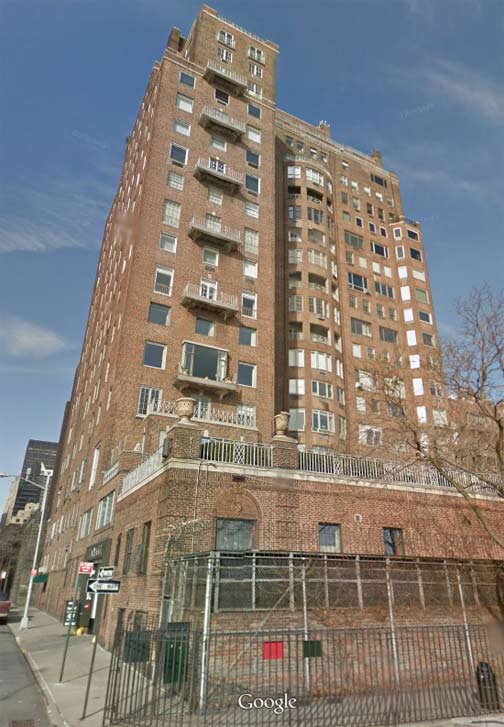
#1 Beekman Place as seen from the FDR Drive
Beekman Place is attained by climbing the Mitchell Place hill from 1st Avenue; on the corner of Mitchell and 1st you will find the Beekman, or Panhellenic, Tower. The first building encountered after making the turn is #1 Beekman Place, designed by Sloan & Robertson and Corbett, Harrison & MacMurray and opened in 1929. Among its tenants have been Prince Ali Khan, A&P heir and arts patron Huntington Hartford, and Margaretta “Happy” Rockefeller, widow of former NYS Governor and Vice-President Nelson Rockefeller.

Beekman Place looking south toward 860-870 United Nations Plaza.
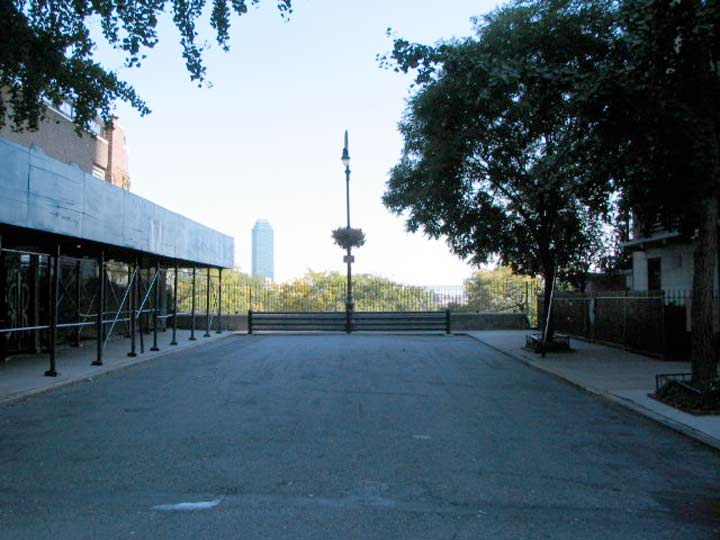
East 50th looking east from Beekman Place
 On older maps, East 50th is subtitled, or alternatively named, Dunscomb or Dunscombe Place. In Old English, dun is hill, while comb is valley; the name means “hill contained within a valley.” The name could have been applied to describe a geological feature, or perhaps, there was a prominent local family called Dunscomb.
On older maps, East 50th is subtitled, or alternatively named, Dunscomb or Dunscombe Place. In Old English, dun is hill, while comb is valley; the name means “hill contained within a valley.” The name could have been applied to describe a geological feature, or perhaps, there was a prominent local family called Dunscomb.
#17 Beekman Place, on the corner of East 50th, is home to the permanent UN mission of the Grand Duchy of Luxembourg, the third of the so-called Benelux European states: Belgium, the Netherlands, and Luxembourg. It is a small country of a little more than a half million population, bordered by Belgium, France and Germany, and is the last remaining world government ruled by a grand duke. Luxembourg is the world’s second largest investment fund center (after the United States), the most important private banking centre in the eurozone and Europe’s leading centre for reinsurance companies. wikipedia French, German and the native Luxembourgish are spoken there.
#17 was home to one of the grand old names in pop music, Irving Berlin, from 1947 until his death at age 101 in 1989. Berlin wrote countless classics of the American songbook, including the “unofficial” national anthem, “God Bless America,” as well as “White Christmas,” Alexander’s Ragtime Band,” “Always,” “There’s No Business Like Show Business” and hundreds of instantly recognizable others.

#23 Beekman Street was the home of Modernist architect Paul Rudolph (1918-1997). The architect constantly tinkered with the interior, making it and remaking it to his changing specifications beginning in 1967. Rudolph specialized in the floor-through interior, and a further renovation done in 2003 after his death stuck to his esthetic. Obsessed with reflective surfaces, Rudolph wedged mirrors and Mylar everywhere. Pieces were found throughout the apartment, sometimes buried in the walls and ceilings.
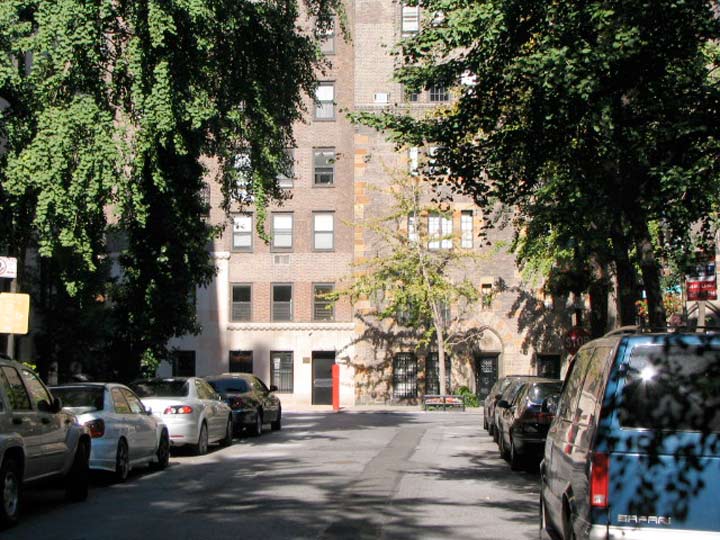
Tree-lined Beekman Place, looking toward East 51st Street. This stretch was home to CBS Chairman Bill Paley and showman Billy Rose.
At the corner of East 51st and Beekman Place is a classic Type 24 Bishop Crook lamp. Now, all of Beekman Place is now lined with retro Bishop Crooks, apparently identical to this one. It takes a trained eye to spot a classic. For one thing the retro versions have fashioed iron garlands entwined around the shafts, and this one doesn’t. But the real telltale is:
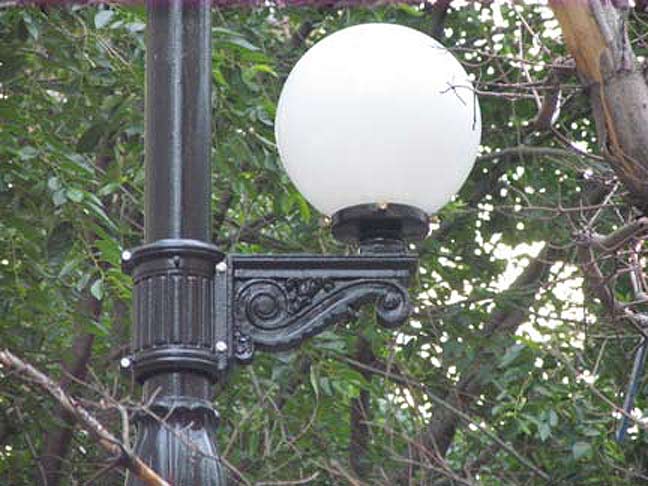
… the presence of a fashioned fire alarm lamp bracket, like this one on a restored post on downtown Warren Street. These short brackets used to hold fire alarm indicators and were designed in the early 1900s for that purpose. New retro versions of cast iron bishop crooks and Corvington posts used modern curved pipes instead, so anytime you see a bracket like this, you’re looking at a pole that could be as much as 80 to 90 years old.

The pole stands in front of a handsome brick building, #39 Beekman Place, known as Hale House in honor of Nathan Hale. Beginning in 1941, it was home to surrealist painter Max Ernst (1891-1976) for a few years.
3/29/14







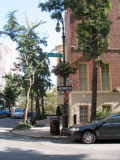

5 comments
Thanks again Kevin for the interesting history lesson and tour of Beekman Place. While Beekman Place proper is restricted to the narrow one way street that runs three blocks between Henry Place and East 51st Street, residents of Henry Place, East 50th Street and East 51Street, east of First Avenue, often claim residence in the “Beekman Place” neighborhood. Beekman Place has long maintained it’s reputation as one of the East Side’s most exclusive address, and this is certainly backed up by it’s celebrated residents, both past and present. The view you took of #1 Beekman Place from 49th Street and the FDR Drive shows the sharp contrast to the building’s front (entrance) facade on Beekman Place; at 49th Street and the FDR Drive there are no street trees, nor do you have the coziness of the almost private street feel of Beekman Place itself. However, the apartments facing the FDR and the East River beyond, have the grander view for which I’m sure they pay a premium for. There doesn’t seem to be one building on Beekman Place that is not architecturally or atleast culturally significant, which contributes to the beauty of the street, and why I’m sure it will continue to attract luminaries to this exclusive enclave.
To me, Beekman Place feels like on of those pocket neighborhoods that are mostly known for the alleys that are there, and the same probably goes for Tudor City and Sutton Place.
Although I am long gone, I have to say I thoroughly enjoyed your piece. The lavish parties I threw, my beloved nephew who came to live with me, that tennis playing airhead who wanted to marry him, Vera the Lush from Pittsburgh – I’d be in tears right now (if I still had eyes, that is). No use for them now, I’m afraid! And please remember – most importantly of all – The Man on the Moon is a LADY!!!
“There are two streets named Beekman in Manhattan, another in the Bronx and one more in Flatbush”
Don’t forget Beekman Circle in Staten Island!
Do you have any History on who Designed & Built #29 Beckmann Place??? Who was it built for ??? The NY Times article said it was owned only by three families!!! Thanks, for any help in this regard!!!